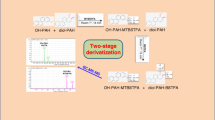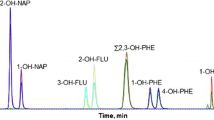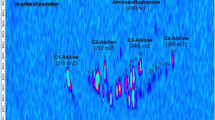Abstract
Polycyclic aromatic hydrocarbons (PAH) are products of the incomplete combustion of organic materials and, therefore, occur ubiquitously in the environment and also in tobacco smoke. Since some PAH have been classified as carcinogens, it is important to have access to suitable analytical methods for biomarkers of exposure to this class of compounds. Past experience has shown that measuring a profile of PAH metabolites is more informative than metabolites of a single PAH. Assessment of environmental and smoking-related exposure levels requires analytical methods with high sensitivity and specificity. In addition, these methods should be fast enough to allow high throughput. With these pre-conditions in mind, we developed and validated a high-performance liquid chromatographic method with tandem mass spectrometric detection (LC-MS/MS) for the determination of phenolic metabolites of naphthalene, fluorene, phenanthrene and pyrene in urine of smokers and non-smokers. Sample work-up comprised enzymatic hydrolysis of urinary conjugates and solid-phase extraction on C18 cartridges. The method showed good specificity, sensitivity, and accuracy for the intended purpose and was also sufficiently rapid with a sample throughput of about 350 per week. Application to urine samples of 100 smokers and 50 non-smokers showed significant differences between both groups for all measured PAH metabolites, and strong correlations with markers of daily smoke exposure in smoker urine. Urinary levels were in good agreement with previously reported data using different methodologies. In conclusion, the developed LC-MS/MS method is suitable for the quantification of phenolic PAH metabolites of naphthalene, fluorene, phenanthrene, and pyrene in smoker and non-smoker urine.

Cumulative frequencies of urinary 4-OH-Phe (left, not significantly influenced by smoking) and 1-OH-Pyr (right, significantly elevated in smokers)



Similar content being viewed by others
References
International Agency for Research on Cancer (1983) IARC monographs on the evaluation of the carcinogenic risk of chemicals to humans. Polynuclear aromatic compounds, Part 1, chemical, environmental and experimental data, Volume 32. International Agency for Research on Cancer, Lyon
International Agency for Research on Cancer. Agents classified by the IARC Monographs Volumes 1–100. http://monographs.iarc.fr/ENG/Classification/ClassificationsAlphaOrder.pdf. Accessed 25 Aug 2010
Hattemer-Frey HA, Travis CC (1991) Benzo-a-pyrene: environmental partitioning and human exposure. Toxicol Ind Health 7:141–157
Phillips DH (1999) Polycyclic aromatic hydrocarbons in the diet. Mutat Res 443:139–147
Dipple A, Chen SC, Bigger AH (1990) Polycyclic aromatic hydrocarbon carcinogens. In: Parizia MW (ed) Mutagens and carcinogens in the diet. Wiley-Liss, LissNew York
Rodgman A, Perfetti TA (2006) The composition of cigarette smoke: a catalogue of the polycyclic aromatic hydrocarbons. Beitr TabForsch Int 22:13–69
Angerer J, Mannschreck C, Gündel J (1997) Biological monitoring and biochemical effect monitoring of exposure to polycyclic aromatic hydrocarbons. Int Arch Occup Environ Health 70:365–377
Jacob J, Seidel A (2002) Biomonitoring of polycyclic aromatic hydrocarbons in human urine. J Chrom B 778:31–47
Simpson CD, Wu MT, Christiani DC, Santella RM, Carmella SG, Hecht SS (2000) Determination of r-7, t-8, 9, c-10-tetrahydroxy-7, 8, 9, 10-tetrahydrobenzo[a]pyrene in human urine by gas chromatography/negative ion chemical ionization/mass spectrometry. Chem Res Toxicol 13:271–280
Lafontaine M, Champmartin C, Simon P, Delsaut P, Funck-Brentano C (2006) 3-Hydroxybenzo[a]pyrene in urine of smokers and non-smokers. Toxicol Lett 162:181–185
Leroyer A, Jeandel F, Maitre A, Howsam M, Deplanque D, Mazzuca M, Nisse C (2010) 1-Hydroxypyrene and 3-hydroxybenzo[a]pyrene as biomarkers of exposure to PAH in various environmental exposure situations. Sci Total Environ 408:1166–1173
Sarkar M, Liu J, Koval T, Wang J, Feng S, Serafin R, Jin Y, Xie Y, Newland K, Roethig HJ (2010) Evaluation of biomarkers of exposure in adult cigarette smokers using Marlboro Snus. Nic Tob Res 12:105–116
US Environmental Protection Agency (1984). Screening methods for PAH priority pollutants in waste water. http://nepis.epa.gov/. Accessed 06 May 2010
Gmeiner G, Krassnig C, Schmid E, Tausch H (1998) Fast screening method for the profile analysis of polycyclic aromatic hydrocarbon metabolites in urine using derivatisation—solid-phase microextraction. J Chrom B 705:132–138
Heudorf U, Angerer J (2001) Urinary monohydroxylated phenanthrenes and hydroxypyrene—the effects of smoking habits and changes induced by smoking on monooxygenase-mediated metabolism. Int Arch Occup Environ Health 74:177–183
Serdar B, Waidyanatha S, Zheng Y, Rappaport SM (2003) Simultaneous determination of urinary 1- and 2-naphthols, 3- and 9-phenanthrols, and 1-pyrenol in coke oven workers. Biomarkers 8:93–109
Hagedorn HW, Scherer G, Engl J, Riedel K, Cheung F, Errington G, Shepperd J, McEwan M (2009) Urinary excretion of phenolic polycyclic aromatic hydrocarbons (OH-PAH) in nonsmokers and in smokers of cigarettes with different ISO tar yields. J Anal Toxicol 33:301–309
Huang W, Caudill SP, Grainger J, Needham LL, Patterson DG Jr (2006) Levels of 1-hydroxypyrene and other monohydroxy polycyclic aromatic hydrocarbons in children: a study based on U.S. reference range values. Toxicol Lett 163:10–19
Benowitz NL, Jacob P III, Bernert JT, Wilson M, Wang L, Allen F, Dempsey D (2005) Carcinogen exposure during short-term switching from regular to “light” cigarettes. Cancer Epidemiol Biomark Prev 14:1376–1383
Chetiyanukornkul T, Toriba A, Kameda T, Tang N, Hayakawa K (2006) Simultaneous determination of urinary hydroxylated metabolites of naphthalene, fluorene, phenanthrene, fluoranthene and pyrene as multiple biomarkers of exposure to polycyclic aromatic hydrocarbons. Anal Bioanal Chem 386:712–718
Jacob P III, Wilson M, Benowitz NL (2007) Determination of phenolic metabolites of polycyclic aromatic hydrocarbons in human urine as their pentafluorobenzyl ether derivatives using liquid chromatography-tandem mass spectrometry. Anal Chem 79:587–598
Li Z, Romanoff LC, Trinidad DA, Hussain N, Jones RS, Porter EN, Patterson DG Jr, Sjodin A (2006) Measurement of urinary monohydroxy polycyclic aromatic hydrocarbons using automated liquid-liquid extraction and gas chromatography/isotope dilution high-resolution mass spectrometry. Anal Chem 78:5744–5751
Rossbach B, Preuss R, Letzel S, Drexler H, Angerer J (2007) Biological monitoring of occupational exposure to polycyclic aromatic hydrocarbons (PAH) by determination of monohydroxylated metabolites of phenanthrene and pyrene in urine. Int Arch Occup Environ Health 81:221–229
Rossella F, Campo L, Pavanello S, Kapka L, Siwinska E, Fustinoni S (2009) Urinary polycyclic aromatic hydrocarbons and monohydroxy metabolites as biomarkers of exposure in coke-oven workers. Occup Environ Med 66:509–516
Smith CJ, Walcott CJ, Huang W, Maggio V, Grainger J, Patterson DG Jr (2002) Determination of selected monohydroxy metabolites of 2-, 3- and 4-ring polycyclic aromatic hydrocarbons in urine by solid-phase microextraction and isotope dilution gas chromatography-mass spectrometry. J Chrom B 778:157–164
Xu X, Zhang J, Zhang L, Liu W, Weisel CP (2004) Selective detection of monohydroxy metabolites of polycyclic aromatic hydrocarbons in urine using liquid chromatography/triple quadrupole tandem mass spectrometry. Rapid Commun Mass Spectrom 18:2299–2308
Grainger J, Huang W, Patterson DG Jr, Turner WE, Pirkle J, Caudill SP, Wang RY, Needham LL, Sampson EJ (2006) Reference range levels of polycyclic aromatic hydrocarbons in the US population by measurement of urinary monohydroxy metabolites. Environ Res 100:394–423
Romanoff LC, Li Z, Young KJ, Blakely NC III, Patterson DG Jr, Sandau CD (2006) Automated solid-phase extraction method for measuring urinary polycyclic aromatic hydrocarbon metabolites in human biomonitoring using isotope-dilution gas chromatography high-resolution mass spectrometry. J Chrom B 835:47–54
Onyemauwa F, Rappaport SM, Sobus JR, Gajdosova D, Wu R, Waidyanatha S (2009) Using liquid chromatography-tandem mass spectrometry to quantify monohydroxylated metabolites of polycyclic aromatic hydrocarbons in urine. J Chrom B 877:1117–1125
Food and Drug Administration (FDA). Guidance for Industry—Bioanalytical Method Validation. http://www.fda.gov/downloads/Drugs/GuidanceComplianceRegulatoryInformation/Guidances/UCM070107.pdf Assessed 17 April 2009
Dixon JR Jr (1998) The International conference on harmonization good clinical practice guideline. Qual Assur 6:65–74
International Conference on Harmonisation of Technical Requirements for Registration of Pharmaceuticals for Human Use (1996) ICH harmonised tripartite guideline. Guidline of good clinical practice E6(R1), http://www.ich.org/MediaServer.jser?@_ID=482&@_MODE=GLB Accessed 31 March 2009
Burns DM, Dybing E, Gray N, Hecht S, Anderson C, Sanner T, O'Connor R, Djordjevic M, Dresler C, Hainaut P, Jarvis M, Opperhuizen A, Straif K (2008) Mandated lowering of toxicants in cigarette smoke: a description of the world health organization TobReg proposal. Tob Control 17:132–141
Verberk MM (1995) Biomarkers of exposure versus parameters of external exposure; practical applications in estimating health risks. Toxicology 101:107–115
Institute of Medicine (2001) Clearing the smoke: assessing the science base for tobacco harm reduction, National Academy Press, http://www.nap.edu/catalog.php?record_id=10029, Washington, D.C
Chen B, Hu Y, Zheng L, Wang Q, Zhou Y, Jin T (2007) Urinary 1-hydroxypyrene concentrations in Chinese coke oven workers relative to job category, respirator usage, and cigarette smoking. Am J Ind Med 50:657–663
Preuss R, Drexler H, Böttcher M, Wilhelm M, Brüning T, Angerer J (2005) Current external and internal exposure to naphthalene of workers occupationally exposed to polycyclic aromatic hydrocarbons in different industries. Int Arch Occup Environ Health 78:355–362
Wang Y, Zhang W, Dong Y, Fan R, Sheng G, Fu J (2005) Quantification of several monohydroxylated metabolites of polycyclic aromatic hydrocarbons in urine by high-performance liquid chromatography with fluorescence detection. Anal Bioanal Chem 383:804–809
Hecht SS, Carmella SG, Le KA, Murphy SE, Li YS, Le C, Jensen J, Hatsukami DK (2004) Effects of reduced cigarette smoking on levels of 1-hydroxypyrene in urine. Cancer Epidemiol Biomark Prev 13:834–842
Hoepfner I, Dettbarn G, Scherer G, Grimmer G, Adlkofer F (1987) Hydroxy-phenanthrenes in the urine of non-smokers and smokers. Toxicol Lett 35:67–71
Hu Y, Zhou Z, Xue X, Li X, Fu J, Cohen B, Melikian AA, Desai M, Tang MS, Huang X, Roy N, Sun J, Nan P, Qu Q (2006) Sensitive biomarker of polycyclic aromatic hydrocarbons (PAHs): urinary 1-hydroxyprene glucuronide in relation to smoking and low ambient levels of exposure. Biomarkers 11:306–318
Ichiba M, Matsumoto A, Kondoh T, Horita M, Tomokuni K (2006) Decreasing urinary PAH metabolites and 7-methylguanine after smoking cessation. Int Arch Occup Environ Health 79:545–549
Jacob J, Grimmer G, Dettbarn G (1999) Profile of urinary phenanthrene metabolites in smokers and non-smokers. Biomarkers 4:319–327
Scherer G, Westphal K, Adlkofer F (1990) Urinary mutagenicity, hydroxyphenanthrene and thioether excretion after exposure to environmental tobacco smoke. In: Kasuga H (ed) Indoor air quality. Springer, Berlin
Sithisarankul P, Vineis P, Kang D, Rothman N, Caporaso N, Strickland P (1997) Association of 1-hydroxypyrene-glucuronide in human urine with cigarette smoking and broiled or roasted meat consumption. Biomarkers 2:217–221
Siwinska E, Mielzynska D, Bubak A, Smolik E (1999) The effect of coal stoves and environmental tobacco smoke on the level of urinary 1-hydroxypyrene. Mutat Res 445:147–153
Suwan-ampai P, Navas-Acien A, Strickland PT, Agnew J (2009) Involuntary tobacco smoke exposure and urinary levels of polycyclic aromatic hydrocarbons in the United States, 1999 to 2002. Cancer Epidemiol Biomark Prev 18:884–893
Suzuki K, Yoshinaga J (2007) Inhalation and dietary exposure to polycyclic aromatic hydrocarbons and urinary 1-hydroxypyrene in non-smoking university students. Int Arch Occup Environ Health 81:115–121
Tsai HT, Wu MT, Hauser R, Rodrigues E, Ho CK, Liu CL, Christiani DC (2003) Exposure to environmental tobacco smoke and urinary 1-hydroxypyrene levels in preschool children. Kaohsiung J Med Sci 19:97–104
Van Rooij JGM, Veeger MMS, Bodelier-Bade MM, Scheepers PTJ, Jongeneelen FJ (1994) Smoking and dietary intake of polycyclic aromatic hydrocarbons as sources of interindividual variability in the baseline excretion of 1-hydroxypyrene in urine. Int Arch Occup Environ Health 66:55–65
Scherer G, Frank S, Riedel K, Meger-Kossien I, Renner T (2000) Biomonitoring of exposure to polycyclic aromatic hydrocarbons of nonoccupationally exposed persons. Cancer Epidemiol Biomark Prev 9:373–380
Hecht SS (2002) Human urinary carcinogen metabolites: biomarkers for investigating tobacco and cancer. Carcinogenesis 23:907–922
Jongeneelen FJ (2001) Benchmark guideline for urinary 1-hydroxypyrene as biomarker of occupational exposure to polycyclic aromatic hydrocarbons. Ann Occup Hyg 45:3–13
Yang M, Koga M, Katoh T, Kawamoto T (1999) A study for the proper application of urinary naphthols, new biomarkers for airborne polycyclic aromatic hydrocarbons. Arch Environ Contam Toxicol 36:99–108
Author information
Authors and Affiliations
Corresponding author
Rights and permissions
About this article
Cite this article
Ramsauer, B., Sterz, K., Hagedorn, HW. et al. A liquid chromatography/tandem mass spectrometry (LC-MS/MS) method for the determination of phenolic polycyclic aromatic hydrocarbons (OH-PAH) in urine of non-smokers and smokers. Anal Bioanal Chem 399, 877–889 (2011). https://doi.org/10.1007/s00216-010-4355-7
Received:
Revised:
Accepted:
Published:
Issue Date:
DOI: https://doi.org/10.1007/s00216-010-4355-7




